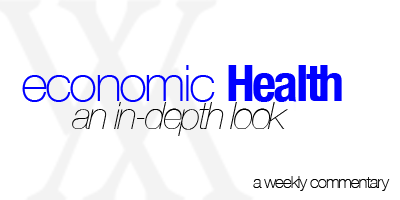KEY TAKEAWAYS
- Since the peak in oil prices in June 2014, consumers saved some, spent some on nonessential items, and paid down some debt, even as measures of consumer sentiment soared.
- The big drop in gasoline prices has not provided a big lift to the consumer sector, which continues to struggle in this recovery, nor did it change the overall tepid trajectory of consumer spending.
- Stubbornly weak wage and income growth, which has a significant impact on consumer spending, remain key constraints on spending.
Click here to download a PDF of this report.
CONSUMER CONSISTENCY
U.S. consumers spent an annualized $302 billion on gasoline and other consumer energy products (home heating oil, natural gas, etc.) in March 2015–aided by the 33% drop in gasoline prices between June 2014 and March 2015–$116 billion (or 28%) less than they spent in June 2014 [Figure 1]. What did consumers do with all the money they saved? With many households still reeling from the 2007-09 Great Recession and its aftermath, and perhaps believing that the drop in energy prices was temporary, consumers saved some, spent some on nonessential items, and paid down some debt, even as measures of consumer sentiment soared. Sound familiar?
Click here for Figure 1, The Drop in Oil Prices Has Saved Consumers $116 Billion.
The big drop is gasoline prices has not, as some expected, provided a big lift to the consumer sector, which continues to struggle in this recovery, nor did it change the overall tepid trajectory of consumer spending. Since the end of the Great Recession–23 quarters ago in Q2 2009–consumer spending has increased by a cumulative 14%, well under the 25% gain seen at this point, on average, in all post-WWII economic recoveries, and the 23% average gain seen in the first 23 quarters of the last three economic recoveries, which are the most comparable to today’s recovery [Figure 2].

SUPPORTS AND CONSTRAINTS
When we last wrote in-depth about the consumer in the November 10, 2014, edition of the Weekly Economic Commentary, “Consumer Conditions,” we noted that while the drop in gasoline prices would be a plus for spending, other factors would likely have a much bigger impact on the consumer, given that gasoline accounts for only 3% of personal spending.
The good news is that the better tone to the labor market, the sharp rise in household net worth (which is the result of the recovery in housing prices, near all-time high equity market levels, and consumers’ paying down debt), and prerecession levels of confidence all act as supports for the consumer. In addition, the precipitous drop in consumer energy prices over the past 9-12 months has left the share of consumer incomes dedicated to purchases of energy (3.5%) near the lowest level in nearly 15 years, providing some breathing room for consumers.
However, stubbornly weak but improving wage and income growth–which have a far bigger impact on consumer spending than any of the positives listed above–remain key constraints on spending. In short, while the big drop in consumer energy prices is a plus, at just over 4% of overall consumer spending (around $300 billion), the category just isn’t large enough to move the needle on overall consumer spending, which is running at over $12.2 trillion.
Figure 3 details the percent change in several key consumer categories since oil prices peaked in June 2014:
- Consumer spending on energy
- Consumer spending on discretionary items
- Consumer savings rate
- Consumers’ debt to income ratio
- Consumer sentiment
- Retail gasoline prices

LARGELY CONSISTENT BEHAVIOR
The big drop in energy spending (28%) and gasoline prices (more than a 30% drop) stands out, although, as noted above, overall energy spending accounts for just over 4% of all consumer spending. The other consumer category that has moved up dramatically since oil prices peaked in June 2014 is consumer sentiment, which moved to an 11-year high in November 2014, before moving lower in early 2015. Consumer spending on discretionary items like cars, movies, televisions, and vacations increased by nearly 4% from June 2014 through March 2015. Consumers also increased their saving rate, perhaps sensing that the drop in energy prices was only temporary. And while spending less on gasoline, more on discretionary items, and saving more, they also managed to pay down some debt.
In many respects, consumers really did nothing different in the past 9-12 months than they did in the early stages of the recovery from the Great Recession, when they also, in aggregate, spent some, saved some, and paid down some debt as the $787 billion economic stimulus package worked its way through the economy. Looking ahead, we continue to see consumer spending running at around two-thirds of normal, supporting gross domestic product (GDP) growth above 3.0% for the remainder of 2015.
IMPORTANT DISCLOSURES
The opinions voiced in this material are for general information only and are not intended to provide or be construed as providing specific investment advice or recommendations for your clients. Any economic forecasts set forth in the presentation may not develop as predicted and there can be no guarantee that strategies promoted will be successful.
Commodity-linked investments may be more volatile and less liquid than the underlying instruments or measures, and their value may be affected by the performance of the overall commodities baskets as well as weather, geopolitical events, and regulatory developments.
This research material has been prepared by LPL Financial.
To the extent you are receiving investment advice from a separately registered independent investment advisor, please note that LPL Financial is not an affiliate of and makes no representation with respect to such entity.
Not FDIC or NCUA/NCUSIF Insured | No Bank or Credit Union Guarantee | May Lose Value | Not Guaranteed by Any Government Agency | Not a Bank/Credit Union Deposit
Tracking #1-379108 (Exp. 05/16)
